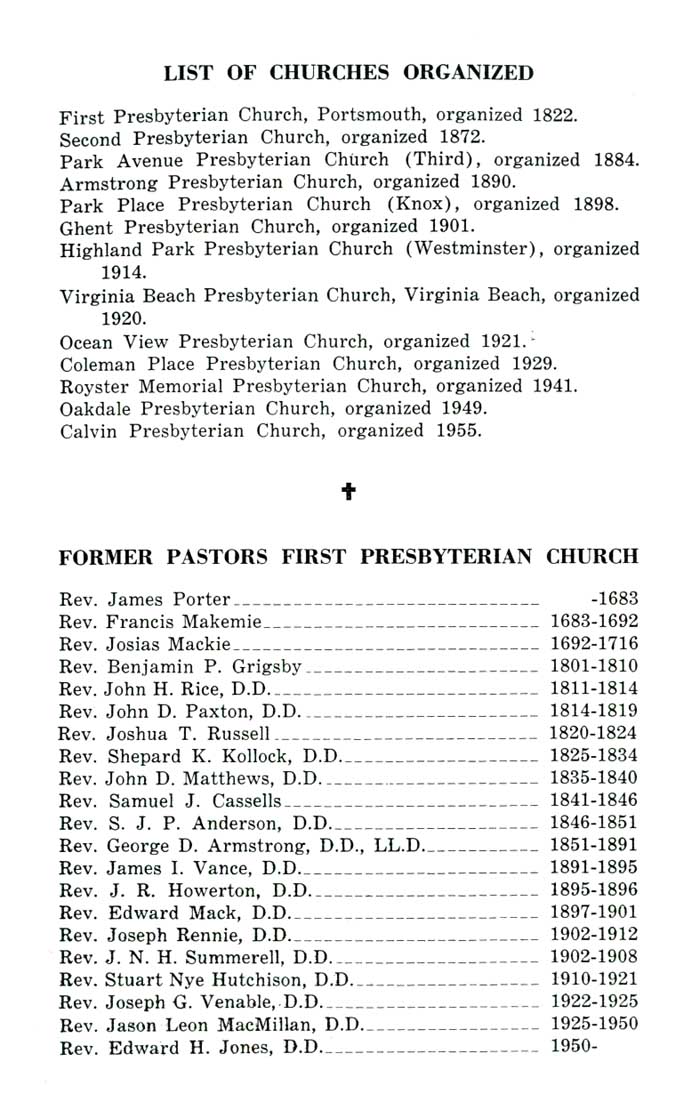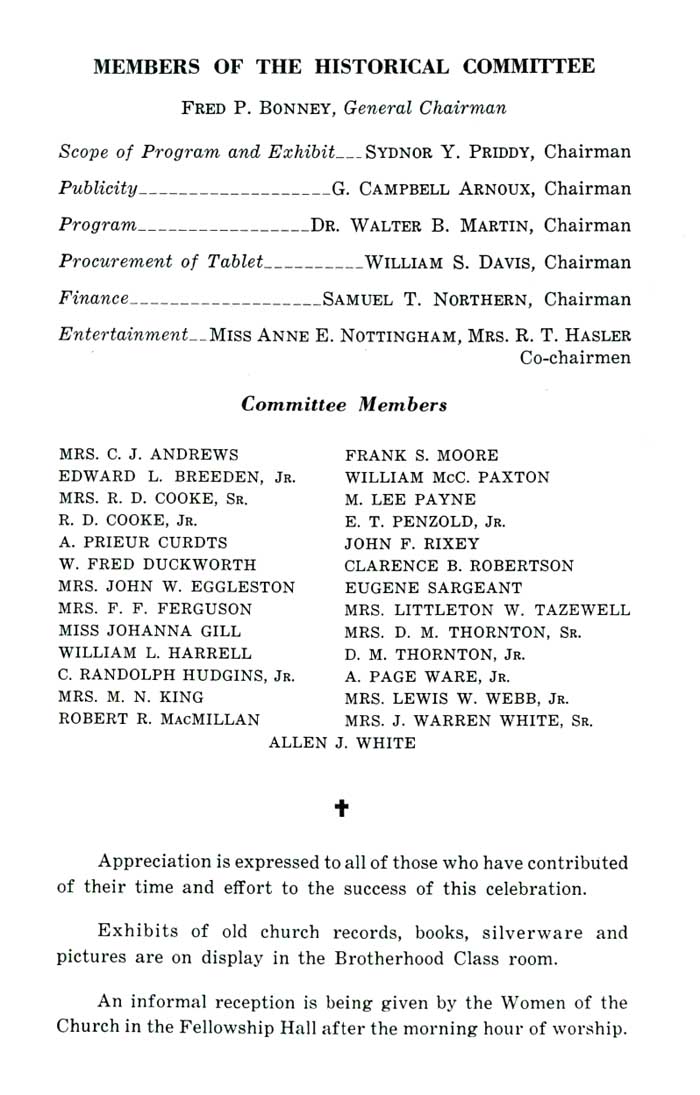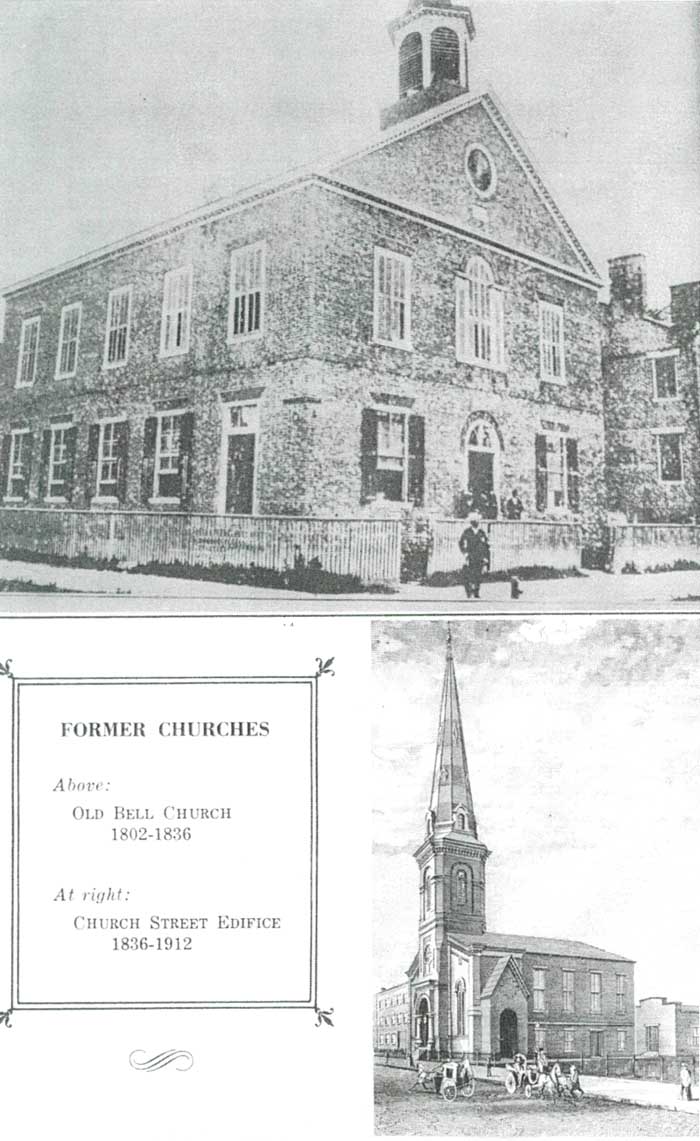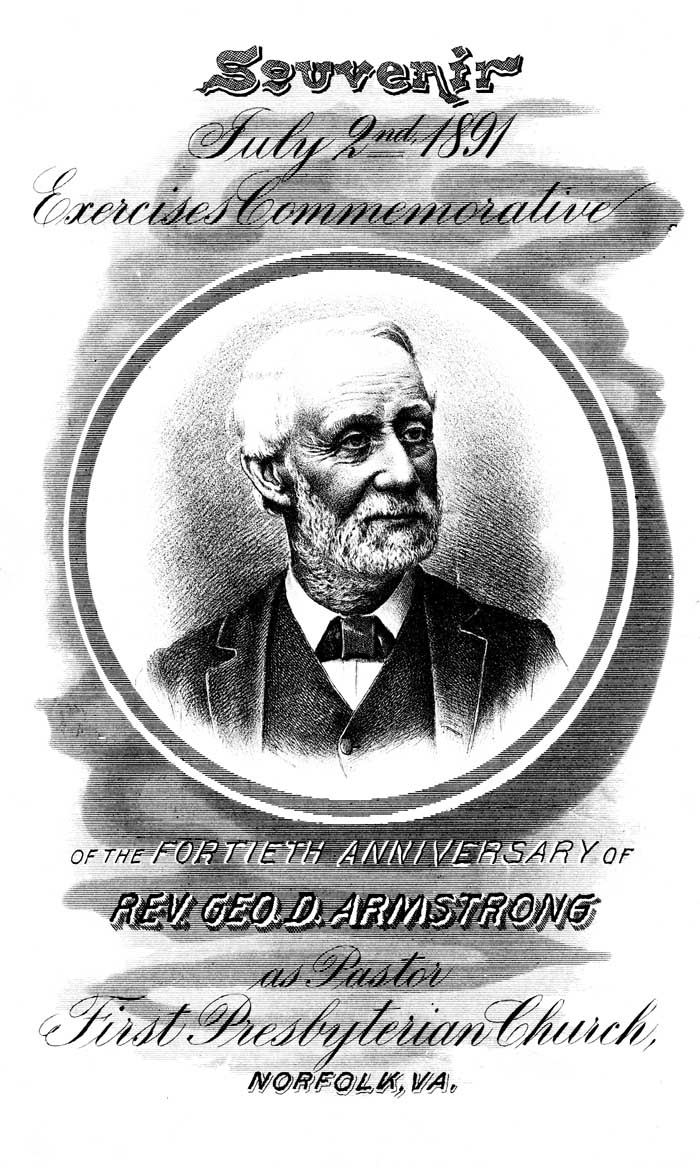
THE HISTORY
OF
FIRST PRESBYTERIAN CHURCH
820 COLONIAL AVENUE, NORFOLK, VAIN
SPECIAL PROGRAMS:
1. Souvenir July
2nd, 1891, Exercise Commemorative
of the Fortieth Anniversary of Rev. Geo. D. Armstrong
as Pastor, First Presbyterian Church, Norfolk, VA.
2. Two
Hundreth and Tenth Anniversary
November 27, 1892.
3. Dedicatory Services of The Ghent Presbyterian Church, February 18, 1912.
4. 230th Anniversary, November 9, 1913
5. Centennial Sunday, October 15, 1961.

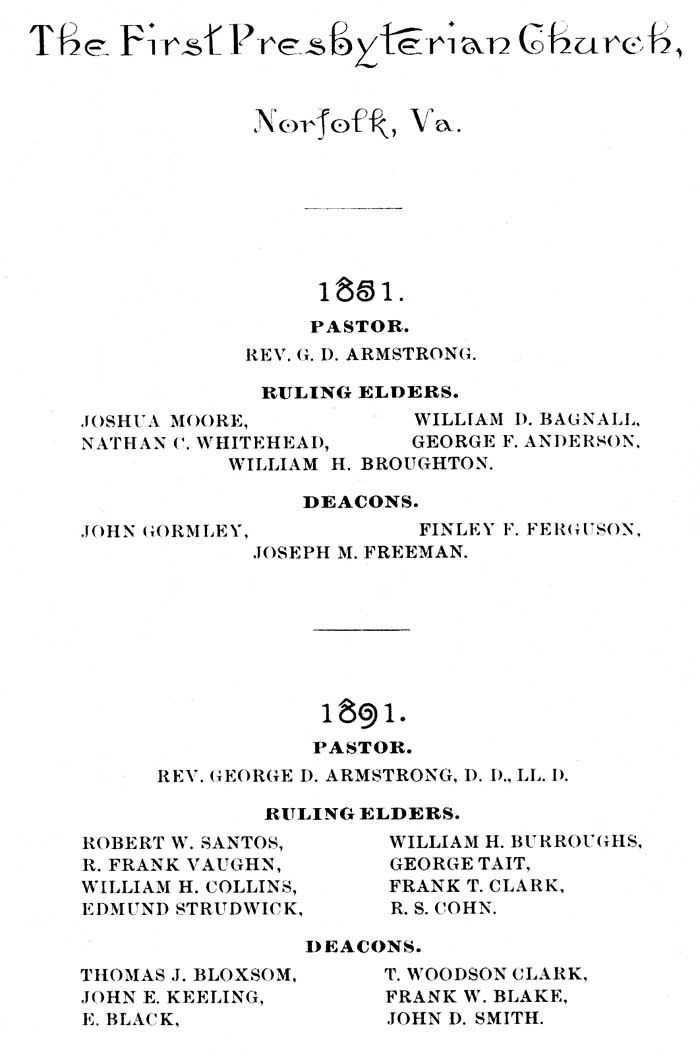
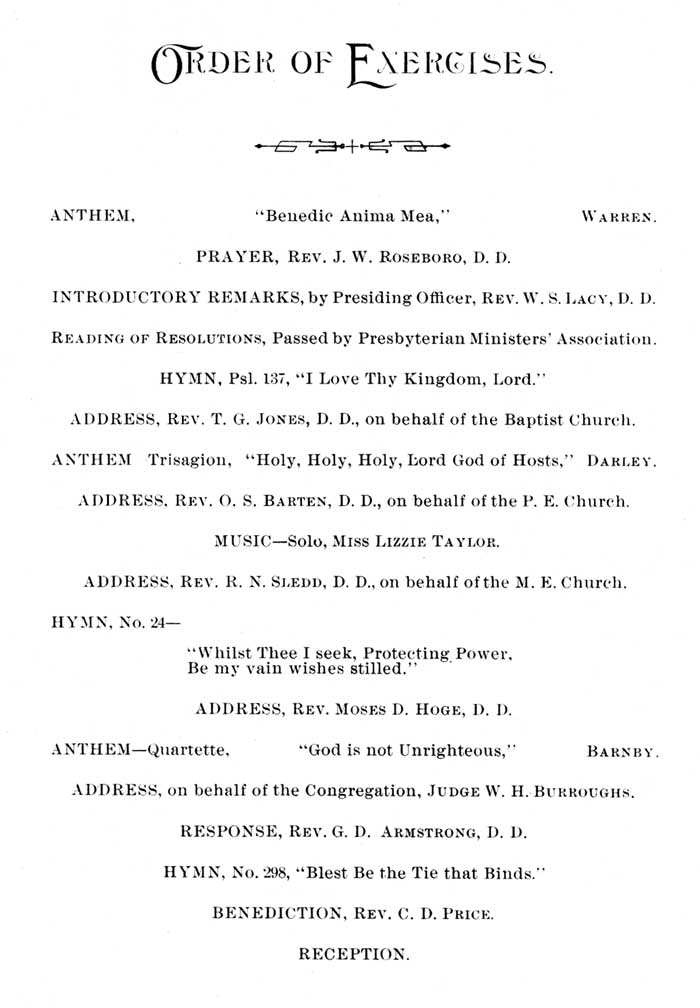
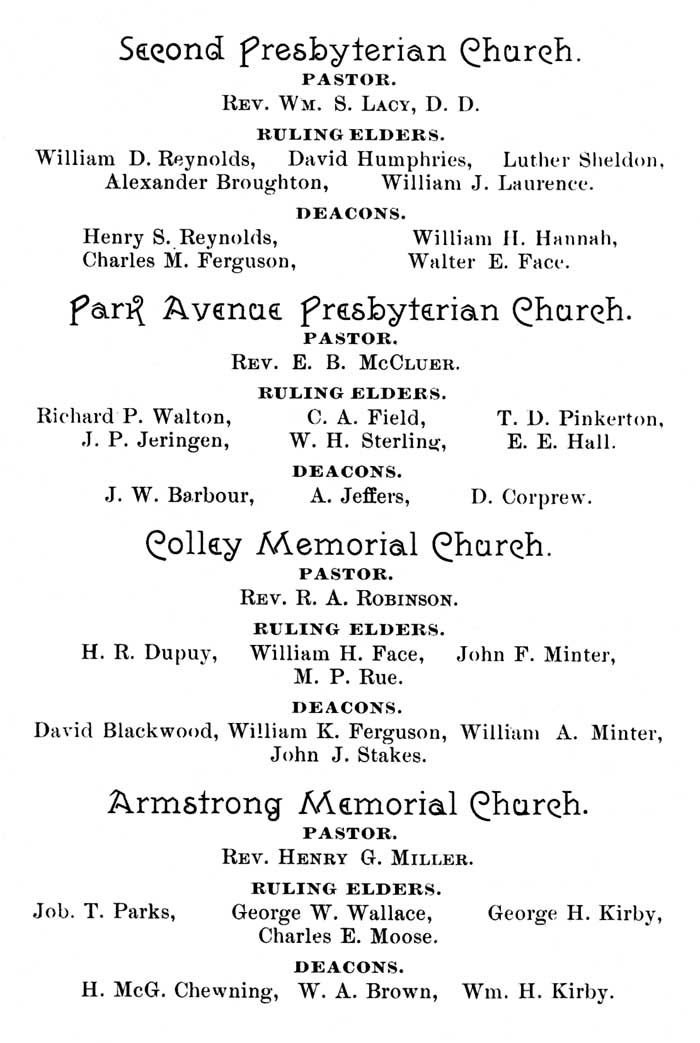

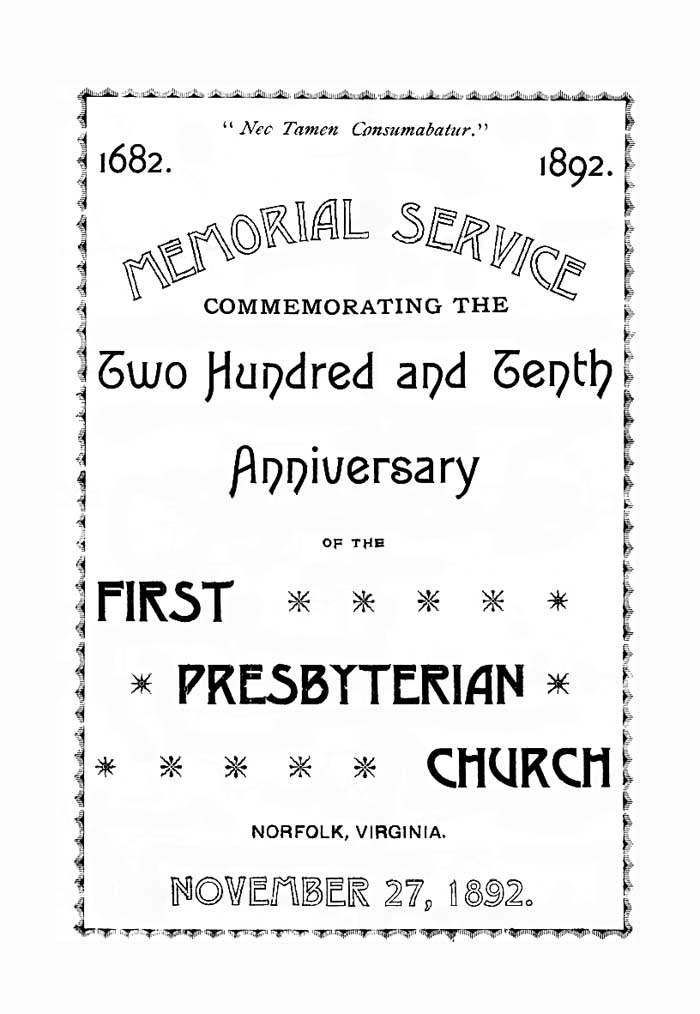
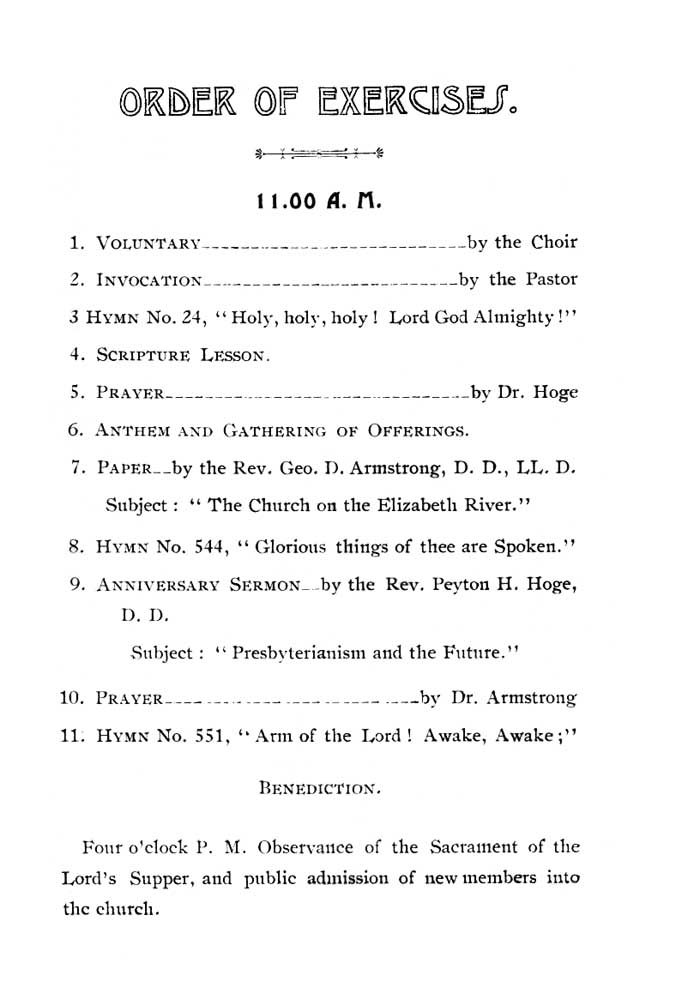
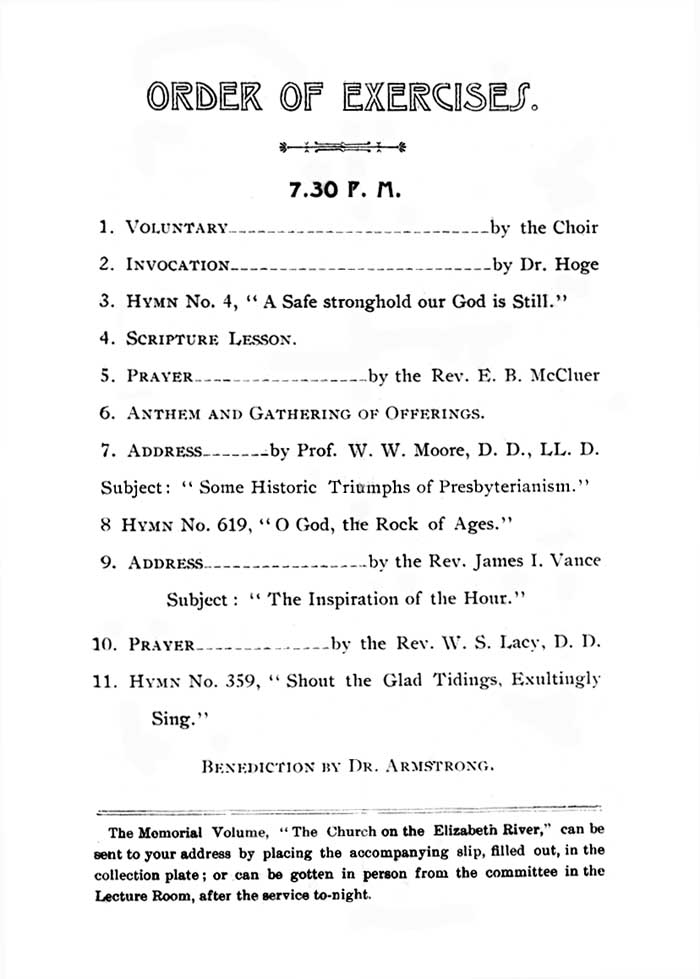
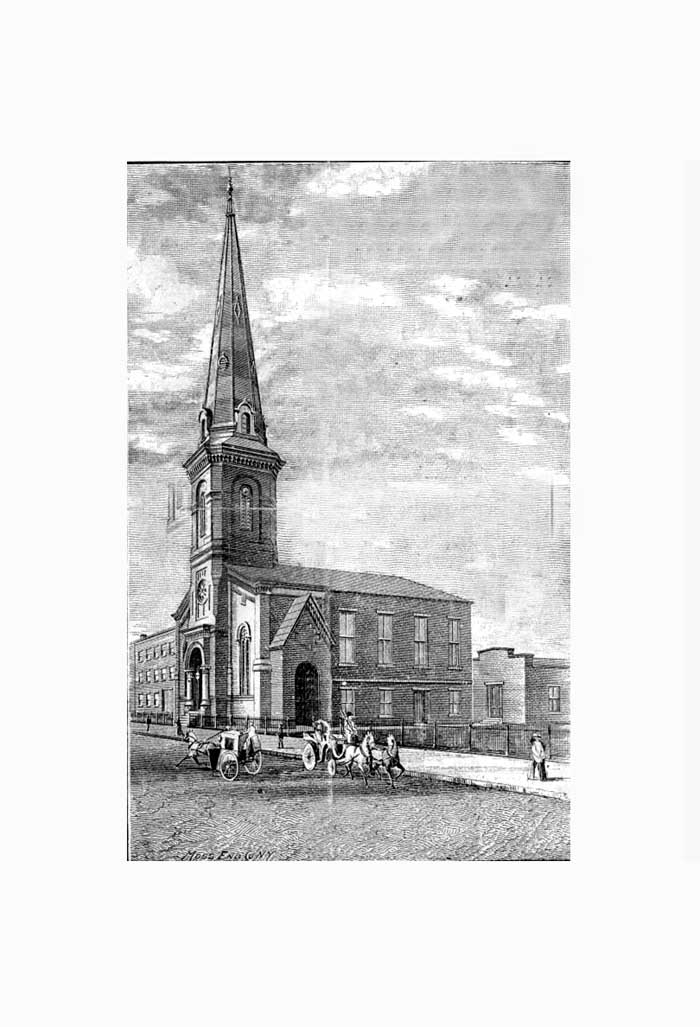
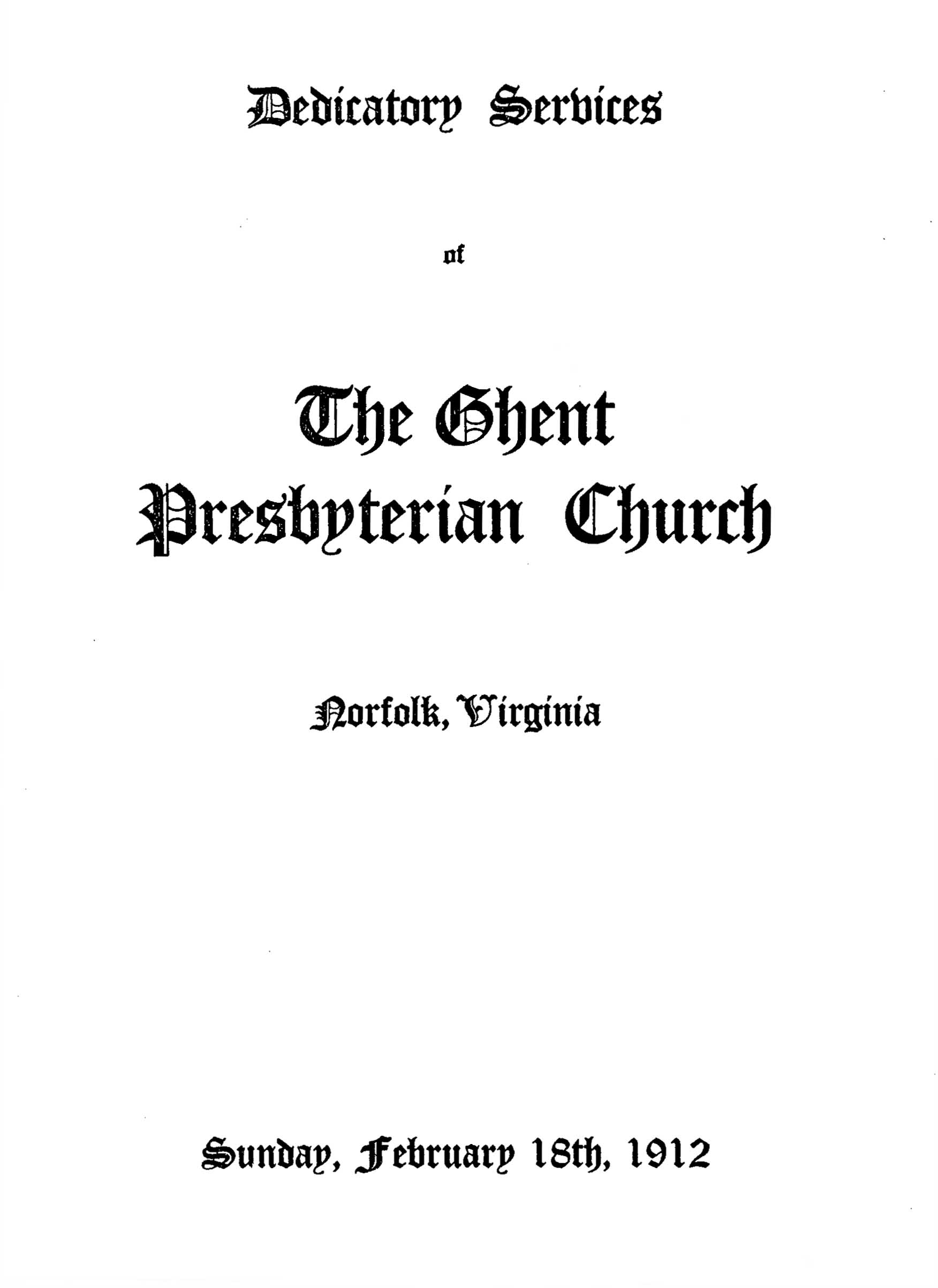
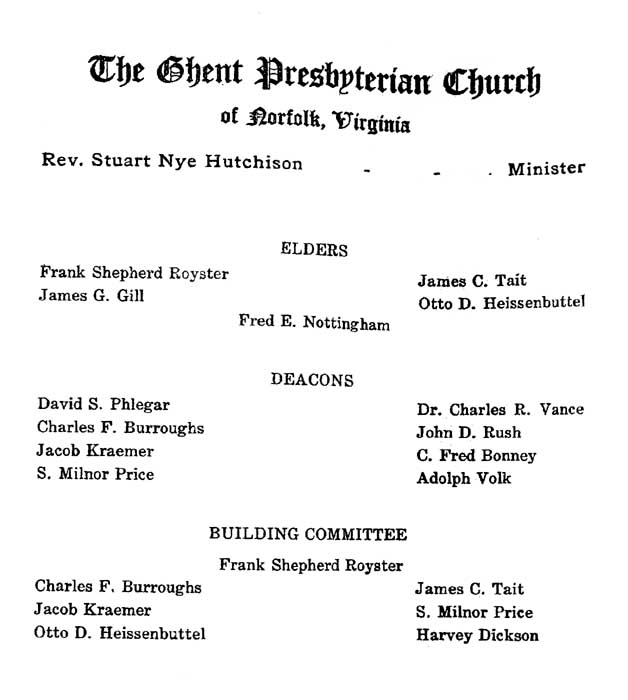
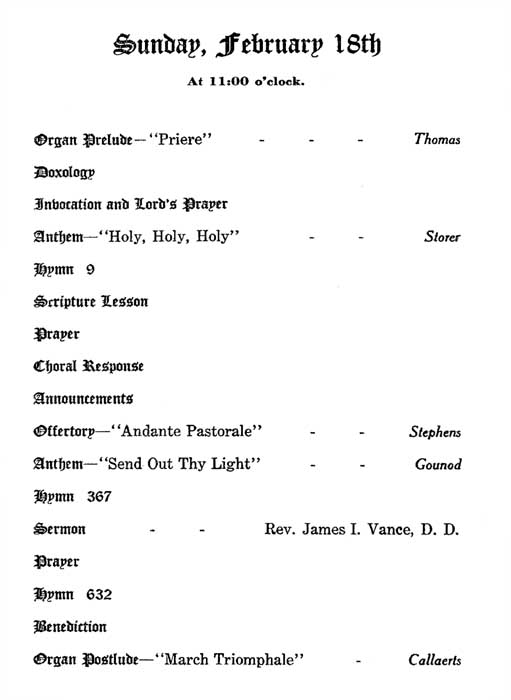
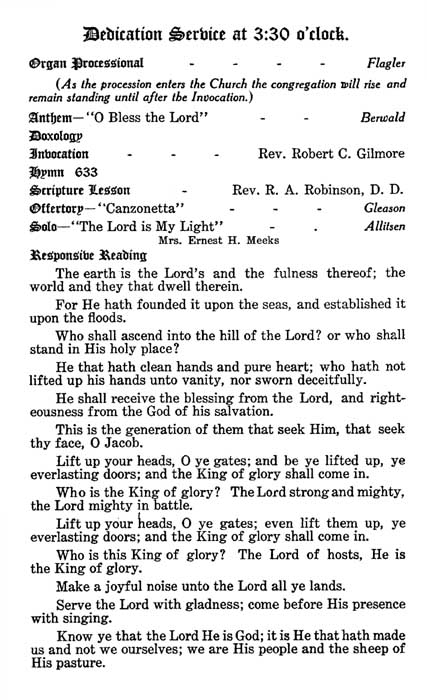
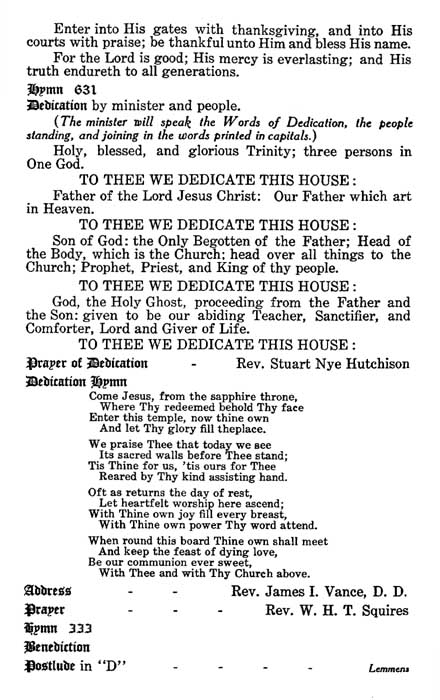
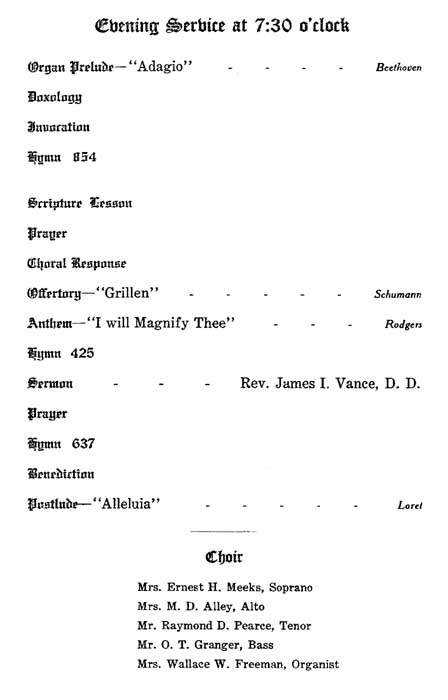
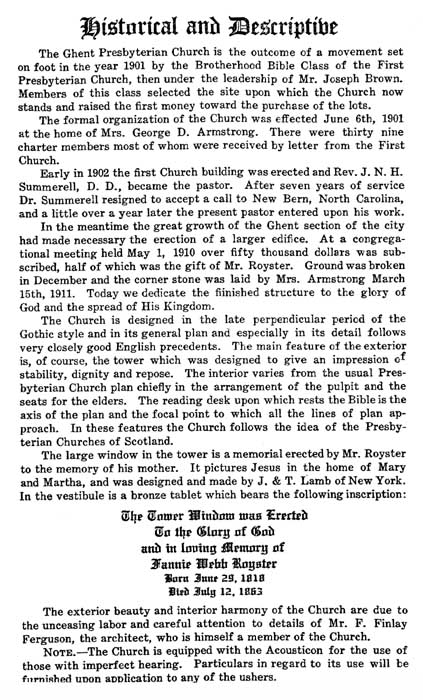
**
* * * *
4.
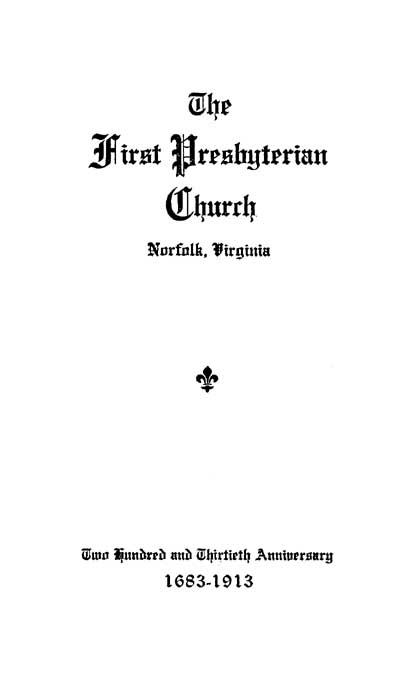
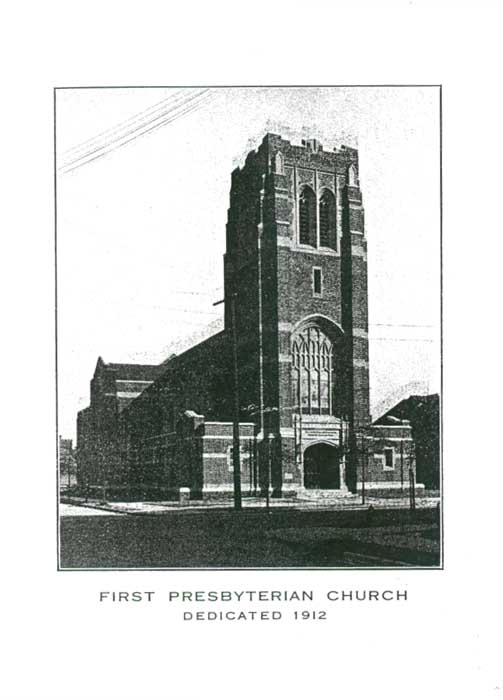
Above: Third church structure.
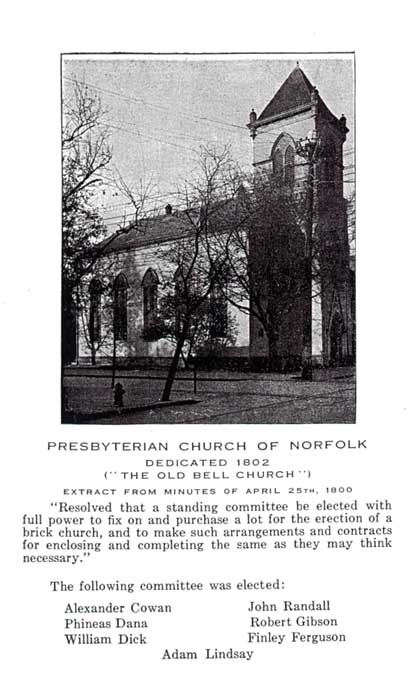
Above: First church structure after renovation by Bank Street Baptists.
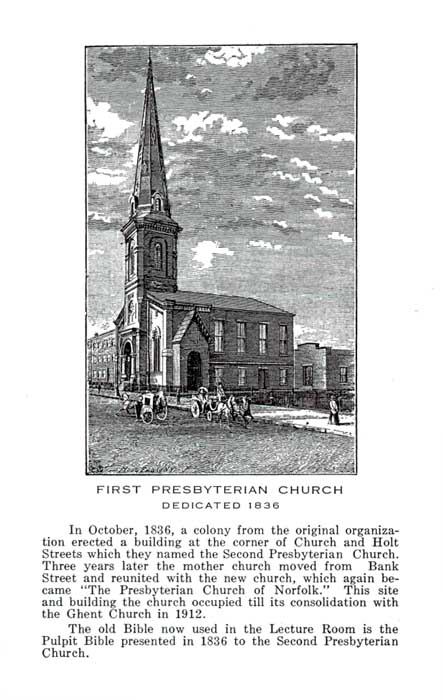
Above: Second church structure.
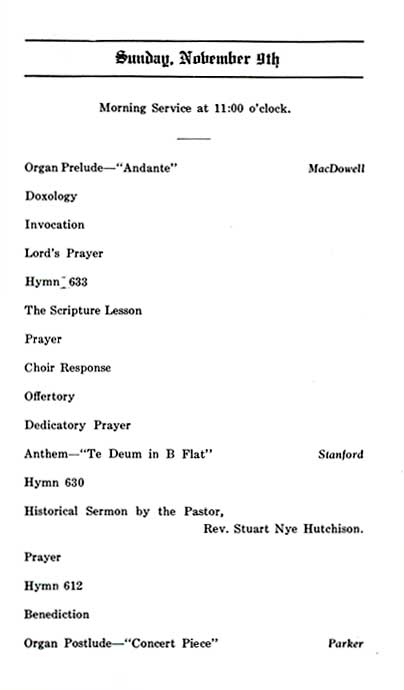
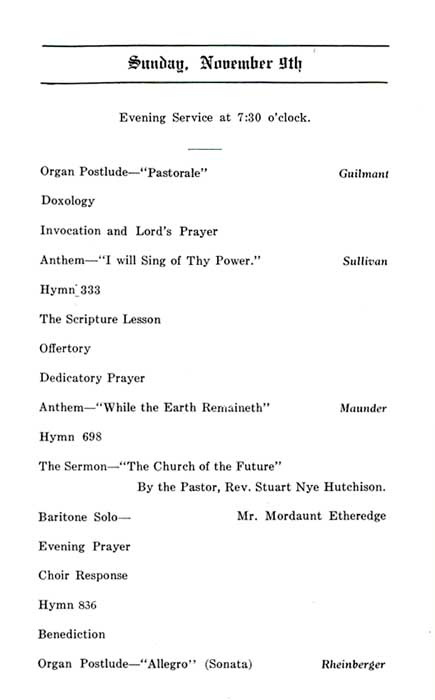
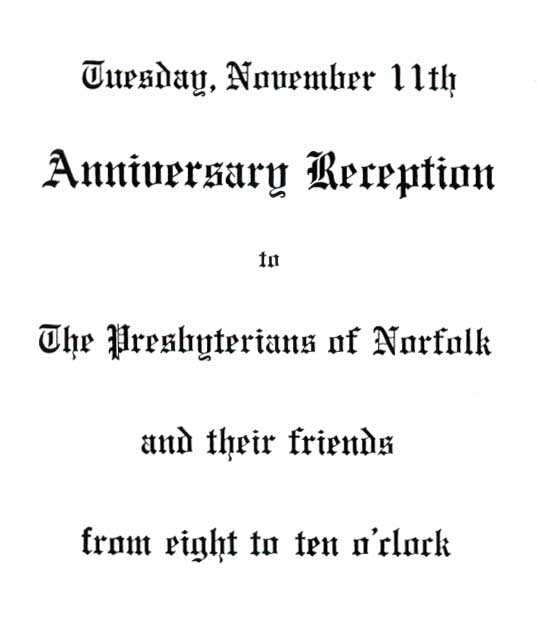
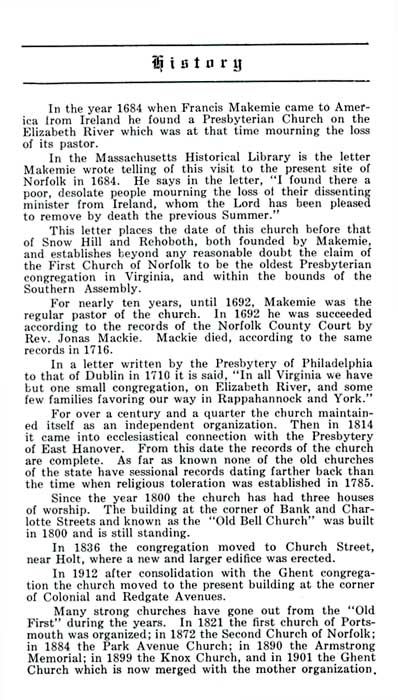
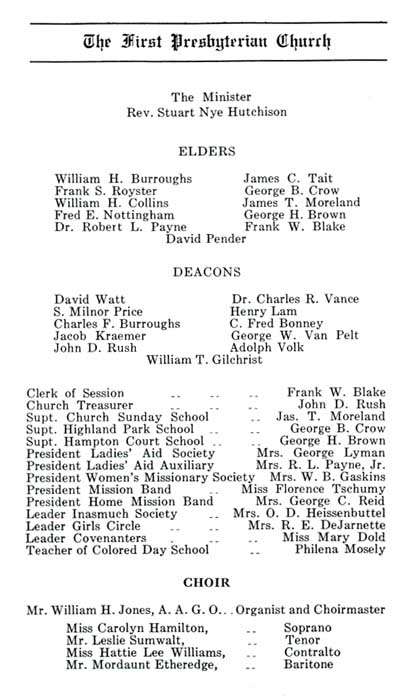
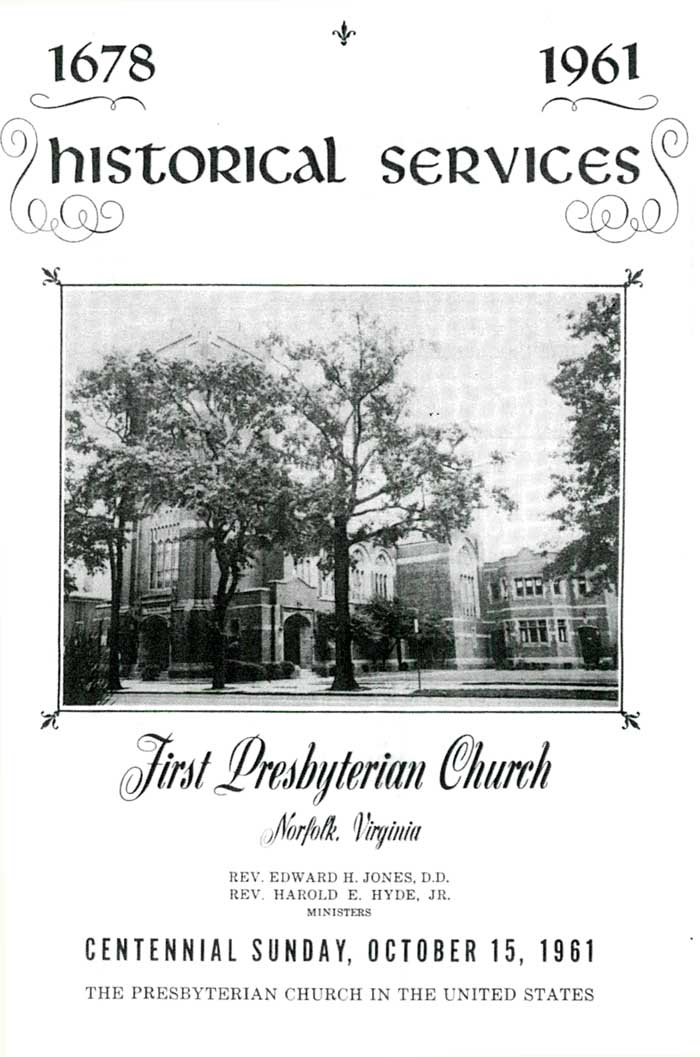
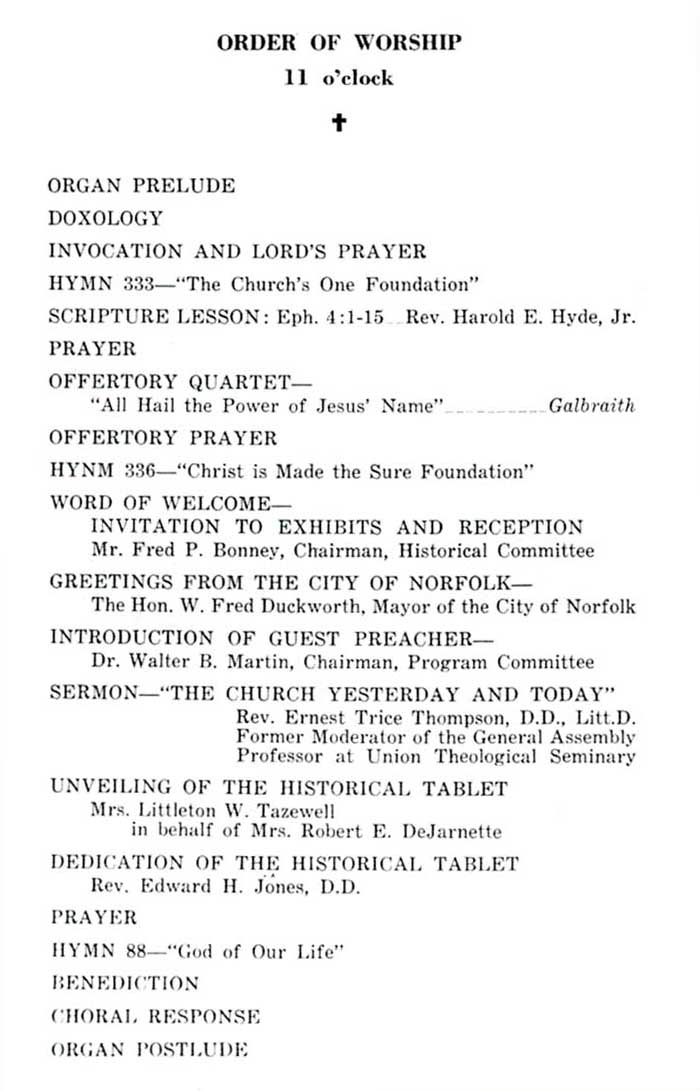
A Brief History 1678-1961 THE FIRST PRESBYTERIAN CHURCH and its predecessors have functioned in the Norfolk area for at least 283 years and probably several years longer. Many devoted and distinguished men, beginning with the first pastor, Rev. James Porter, circa 1678, to Dr. Edward H. Jones, our present pastor, have filled its pulpits. The first congregation was known as the Church on the Elizabeth River which had no church building of its own, because of oppressive laws; and no preaching allowed even in a private home without special permission. On the death of the first young pastor, 5 years after his marriage, Francis Makemie came in 1683 and ministered to the congregation until 1692; the third pastor, Josias Mackie, took charge in that year relieving Mr. Makemie for other charges, and remained as pastor until 1716. There was still no church building but permission had been obtained to preach in four homes in the area. From the time of Mr. Mackie's death in 1716, for the next three-quarters of a century practically nothing is known of the progress and activity of the Presbyterian Church in Norfolk. No records are extant, and the pages of its history for that 75 years are blank. In 1784 however—after the end of the Revolution—a new era dawned. The Act for the Establishment of Religious Freedom was passed and religious persecution ceased. A group of 25 devoted people met April 25, 1800, in the Court House and made plans to build a brick church. A campaign for funds realized $12,000 from 87 people. The pastor was to be paid from pew rentals. The church, located on the corner of Catherine (now Bank) and Charlotte Streets, was the only one with a bell and was known as the Bell Church. Its first pastor was Benjamin Porter Grigsby, but his service was brief as he died a victim of yellow fever. It is believed that Rev. John Holt Rice, DD, served the church the next four years, though he lived in Richmond and later founded Union Theological Seminary. Little is known of the next pastor, the Rev. John D. Paxton, DD, who filled the Bell Church pulpit from 1815 to 1819. He was followed in 1820 by Rev. Joshua T. Russell; during his pastorate a church in Portsmouth was founded. Next came Rev. Shepard K. Kollock, DD, a native of New Jersey; then Rev. John D. Matthews, DD, from 1835 to 1840. During his pastorate the congregation built a new church, located across from St. Paul's Church on Church Street; and 125 members left the congregation to go to the new church which was called the Second Church. By an order of the Presbytery, Bell Church, after 35 years of service, closed its doors, and the two congregations merged, with the original name of the First Church. The next pastor was Rev. Samuel J. Cassells, from 1841 to 1846. During his pastorate the first Deacons were elected, in 1842. Mr. Cassells was succeeded by Rev. Samuel J. P. Anderson, DD, from 1846 to 1851, and following him Rev. George D. Armstrong, DD, who served the church for 40 years from 1851 to 1891. A young man then, Dr. Armstrong was called upon for great services and sacrifices. During the yellow fever epidemic, when 11 of the 15 doctors lay dead, and death took his wife and three of his children; when there were 1200 to 1500 cases of yellow fever, he was a ministering angel to his congregation. When the epidemic was over and church services were resumed, the depleted congregation numbered between 60 and 80. During the War Between the States, Dr. Armstrong was denied his own pulpit for a period of 15 months, and he suffered imprisonment at Old Point Comfort and at Hatteras. At the close of the War, the membership numbered 200, but by 1871 it had increased to 325. The next period in the history of the church has been referred to as the "Period of Colonization." It began with the organization of the Second Church in 1872, followed by numerous other successful ventures in creating new churches. Dr. Armstrong resigned the active pastorate in 1891 and was elected Pastor Emeritus, and was followed by Rev. James I. Vance, DD, until 1895; under his pastorate rented pews were abolished. Next came Dr. J. R. Howerton, who served from 1895 to 1896; then Rev. Edward Mack, DD, from 1897 to 1901. One of the final acts of his pastorate was the organization of Ghent Church, October 13, 1901. A men's Bible Class was founded in 1899, known as the Joseph Brown Bible Class—later the Brotherhood Bible Class. This class bought several lots at Colonial and Redgate Avenues, which later became the site of our present church. Dr. Joseph Rennie, in 1902, became pastor and served 10 years. During his pastorate the 76 years occupancy of the Church Street Church terminated; and the invitation to merge with Ghent Church—its newest child—was accepted by the First Church. The first service of the united congregation took place April 7, 1912 with the name of First Presbyterian Church and the location at Colonial and Redgate Avenues. Rev. Stuart Nye Hutchison, DD, was pastor of the united congregation, serving until 1921. During his pastorate the Women's Auxiliary and Circle plan was inaugurated, and Highland Park and Ocean View Churches were successfully established. Rev. Joseph G. Venable, DD, succeeded Dr. Hutchison and was pastor until 1925. His pastorate was marked by the purchase of a house on Redgate Avenue to provide space for an expanding Sunday School. A long and successful pastorate was begun by Dr. J. L. MacMillan in 1925. During his term the Sunday School and Church house plant was added; and the system of rotation in office of Elders and Deacons was inaugurated in 1934. On February 1, 1950, after a quarter-century of devoted service, Dr. MacMillan resigned and was shortly elected Pastor Emeritus which title he bore with distinction until his recent death. The pulpit was vacant until November 1, 1950, at which time Dr. Edward H. Jones became pastor and this year will celebrate his eleventh anniversary. Under his able leadership a campaign was successfully carried out in 1955 to build Calvin Presbyterian Church, and the church property was enlarged and improved,—first by the purchase of property on Colonial Avenue which was landscaped and added quality to the beauty and dignity of the church building, and next by the purchase of lots on Raleigh Street which were made into a church parking area to fill an urgent need. Another first in Dr. Jones' tenure was the inauguration of the first live telecasting of complete church services in November of 1957. This was the first church in Virginia to use TV and it added thousands of people to its congregation, being a particular boon to the shut-ins of the area. Nearly three centuries have passed since that courageous band of Presbyterians gathered in the homes of members on the Elizabeth River to worship God according to the dictates of their conscience and still today the same challenge of the future summons us, their descendents, to greater faith, courage, and consecration in the great unfinished task of making Christ known as the Redeemer of mankind and the Saviour of the world.
